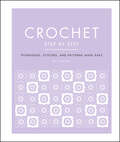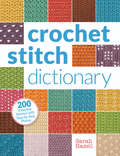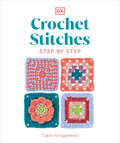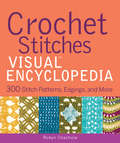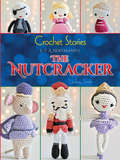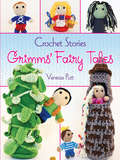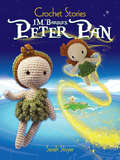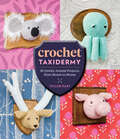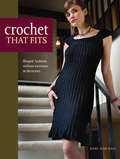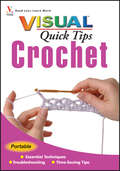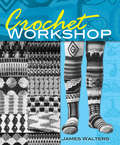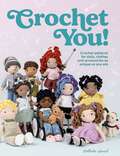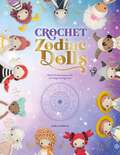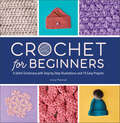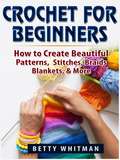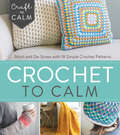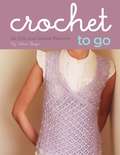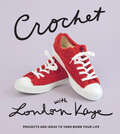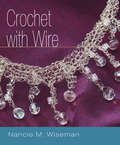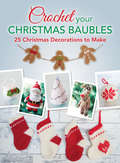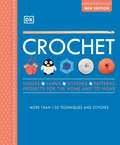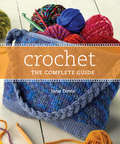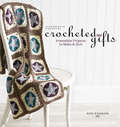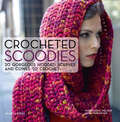- Table View
- List View
Crochet Step by Step: Techniques, Stitches, and Patterns Made Easy (DK Step by Step)
by Sally HardingGet hooked on crocheting with this crochet book for beginners! Filled with step-by-step illustrations for an easy-to-follow and fully visual experience, this foolproof guide will have you starting your first crochet project right away!If you&’ve always wanted to learn how to crochet but thought it would be too tough, this is the ultimate book for you! From choosing the right hooks and crochet yarn to basic stitches and patterns, Crochet Step By Step explains all the tools, materials, and techniques you&’ll need to get started. You&’ll be making scarfs, blankets, baby hats, and cushions in no time!Inside the pages of this illustrative crochet reference guide, you&’ll find: • Over 100 key techniques and 20 easy projects to get you started • Clear step-by-step photography and easy-to-follow instructions • Advice on what materials you need and how to use them • An introduction to color theory and how to combine colors for optimum effect Even if you&’ve never held a crocheting needle in your hand, the detailed illustrations and instructions will transform you into a crochet master! There are more than 100 techniques and crochet patterns to try, each explained step by step, with clear terms and methods. This basic crochet book includes a concise explanation of stitch symbols and abbreviations together with clear guidelines on how to read crochet patterns. There are 20 projects to practice what you&’ve learned about stitches, techniques, and tools, so you can go from a novice to an expert crocheter! There's also helpful advice on which color combinations to use for beautiful results. On Your Marks. Get Set. Stitch!This newly updated edition includes a fresh design and brand-new photography that shows the stitches with gorgeous clarity. Gorgeous photos of finished projects will inspire you to pick up your crochet hook and get creative! It&’s the perfect gift for anyone who wants to learn how to crochet.Complete the Series:Fully illustrated and easy to use, the DK Step by Step series covers all the essential skills and techniques you need to succeed in all sorts of hobbies, whether you&’re a newbie or not. Once you&’ve mastered the art of crocheting with Crochet Step by Step, why not learn how to master key carpentry skills in Woodwork Step by Step?
Crochet Stitch Dictionary: 200 Essential Stitches with Step-by-Step Photos
by Sarah HazellA great gift for new and experienced crocheters alike, Crochet Stitch Dictionary offers 200 stitches with detailed written, charted, and photographed instructions. With colorful and eye-catching "candy-box" sampler pages that start every section, this essential book presents hundreds of stitches organized in 10 color-coded sections: - Basic stitches- Fans & Shells- Bobbles & Clusters- Spike stitches- Post stitches- Mesh & Filet- Cable stitches- Tunisian stitches, and more!Each stitch pattern shows a large finished swatch in actual size, along with step-by-step photo instructions that clearly explain where the yarn goes each step of the way. Crochet Stitch Dictionary offers excellent useful instruction and inspiration for all crocheters.
Crochet Stitches Step-by-Step: More than 150 Essential Stitches for Your Next Project
by Claire MontgomerieA modern, photographic directory of over 150 crochet stitches, covering techniques including granny squares, amigurumi, and Tunisian crochet.An inspirational, practical guide to more than 150 crochet stitches. Take your crochet to the next level with Crochet Stitches Step-by-Step. This essential guide opens a world of possibilities for crocheters of all abilities, with a huge range of stitches to inspire your next project. Discover how to combine stitches to create eye-catching granny squares and mandalas, design amigurumi toys, and try your hand at techniques including Tunisian crochet and C2C. This essential collection of must-try stitches will offer something for every crocheter and every project, with tips on finding the right techniques to create everything from blankets and sweaters to socks and toys. Every stitch is accompanied by full instructions, with clear photographs and annotations so that you can follow even the trickiest of methods with ease. The book also covers the hooks, yarn, and tools you&’ll need, along with essential know-how for blocking, sewing, and finishing your work.With an at-a-glance gallery to help you find the perfect stitch for your next project, this modern classic is a must-have for crocheters of all ages and abilities.
Crochet Stitches VISUAL Encyclopedia
by Robyn ChachulaVisual instruction for 300 crochet stitch patterns This visual encyclopedia features step-by-step instructions for 300 gorgeous crochet stitch patterns, from basic stitches to cables, lace, textured stitches, mesh and filet crochet, fans and shells, clusters, puffs, bobbles, spike stitches, colorwork, and more. Each pattern is accompanied by a full-color photo and a chart. Every crocheter needs a book like this on her shelf-the content is timeless and will have a place next to the crochet hooks for many years to come. Crochet Stitches VISUAL Encyclopedia gives crocheters quick visual access to a comprehensive collection of stitch combinations that enables them to create their own designs or modify existing patterns with ease. Patterns are represented in both charts and words to suit individual crocheters' preferences A detailed color photo accompanies each stitch pattern Hardcover packaging makes the book durable for a lifetime of use Whether you're a beginner or an advanced crocheter, Crochet Stitches VISUAL Encyclopedia is a book you'll turn to again and again.
Crochet Stories: E. T. A. Hoffmann's The Nutcracker (Dover Knitting, Crochet, Tatting, Lace)
by Lindsay Smith"This is a beautifully well done crochet book. The Nutcracker story is told with each vignette, introducing a different character or accessory to craft. I would highly recommend adding this to your collection." -- Fit2BTiedLifeExperience the enduring charms of the holiday classic in an entirely different way! This version of the beloved tale is illustrated with full-color images of crocheted characters. Each chapter of the adventure - from the Christmas Eve party to the fierce battle between the Nutcracker and the Mouse King to the visit to Toyland and beyond - features complete instructions for crocheting charming representations of the story's personalities and props.Twelve easy-to-follow patterns depict Marie and her Nutcracker, the Mouse King, the enchanted clock, a Christmas tree surrounded by wrapped gifts, and other festive figures. Well-illustrated instructions specify yarn colors, materials, gauge, and abbreviations for stitches; a Techniques section offers guidance to crocheters. All patterns specify yarns that are readily available in craft stores. The ideal gifts for all Nutcracker enthusiasts, these amigurumi figures are keepsake treasures that will brighten every holiday season
Crochet Stories: Grimms' Fairy Tales
by Brothers Grimm Vanessa Putt Gloria Cavallaro"Incredibly innovative, fun, and creative, Crochet Stories: Grimms' Fairy Tales is something you can share with your loved ones for many years and it will surely inspire you to go on to create even more fairy tale characters." -- Erisea Mag"Absolutely adorable." -- Shadows' ReachPractitioners of amigurumi, the Japanese art of crocheting stuffed dolls, will adore this collection of sixteen playful patterns for fairy tale figures. Projects include the witch and the gingerbread house as well as the hero and heroine of "Hansel and Gretel"; the giant and the golden goose's eggs of "Jack and the Beanstalk," in addition to the beanstalk and Jack himself; the long-haired captive of "Rapunzel," her lonely tower, and her rescuer, the prince; the animals of "The Hare and the Hedgehog" plus a juicy carrot; and the wee subject of "Tom Thumb" and his cow.Clear instructions for creating the characters are accompanied by color photos of the finished products along with charming retellings of all five fairy tales. An introductory chapter offers general notes and tips, including pointers on working in the round, stuffing, measurements, and finishing."Sure to delight and inspire! A charmingly whimsical repository of achievable patterns." -- The Bookshelf Gargoyle
Crochet Stories: J. M. Barrie's Peter Pan (Dover Crafts: Crochet)
by Sarah SloyerTravel to Never-Never Land with this "crafty" retelling of the adventures of the boy who wouldn't grow up. The book features a brief version of J. M. Barrie's classic tale, Peter Pan, punctuated with more than a dozen well-illustrated patterns for the beloved characters, plus a variety of accessories.The ever-popular story opens in the London nursery of the Darling household, presenting patterns for Peter, Wendy and her brothers, and Nana the dog. Storybook chapters of the young Darlings' adventures in Never-Never Land follow, alternating with patterns for Captain Hook, Smee, the crocodile, Tinkerbell, the Lost Boys, the pirate ship, and other whimsical projects that range from easy to intermediate to advanced.
Crochet Taxidermy: 30 Quirky Animal Projects, from Mouse to Moose
by Taylor HartCrochet Taxidermy puts a new twist on amigurumi, the popular Japanese method of creating considerably cute stuffed animals with oversized heads. In this delightful collection, heads of animals from farm and forest, sea and safari come to life with irresistible details like the drowsy eye (for the shy deer and sleepy octopus) and fuzzy yarn (for the skittery skunk’s stripe and lazy lion’s mane). Step-by-step instructions and adorable photos guide you through these 30 easy crochet patterns. Most require just one skein of yarn, so they’re affordable and quick to crochet!
Crochet That Fits: Shaped Fashions Without Increases or Decreases
by Mary Jane HallSay "goodbye" to crochet's stiff, boxy, hippie-child reputation and "hello" to Crochet that Fits-garments that fit your shape accessories that fit your style, and looks that fit right in with today's fashion trends! This book teaches an innovative, easy way to crochet fashions that are soft, shaped and drape able-from a little black dress that fits like a glove and a lacy baby-doll top, to cute and cozy slippers, ruffled shrugs and hobo bags. By using Mary Jane Hall's Graduated Stitch Method, along with the correct size hook and yarn, anyone can make flattering, form-fitted items! Different stitch heights do all the shaping for you, without the hassle and confusion of figuring out increases and decreases. With this method you are essentially building garments with squares and rectangles, but the finished product doesn't look at all boxy. • 33 step-by-step projects feature a wide variety of patterns for adults and children • An illustrated stitch guide get even beginners started quickly • Detailed instructions make it easy to adjust the patterns to suit your shape (or others') because one side doesn't fit all! Easy enough for a beginner and stylish enough for the more experienced crocheter, these are projects you'll enjoy making and feel good wearing. With fits like this, you'll never think about crochet in the same way again!
Crochet VISUAL Quick Tips
by Cecily Keim Kim P. WerkerSolutions to common crochet quandaries are at your fingertips--anywhere you goCrochet VISUAL Quick Tips has the answers you need--fast. With detailed color photos and concise instructions, plus time-saving tips, it covers:Selecting tools and yarnWorking basic stitchesIncreasing and decreasingWorking in rounds and colorsMaking puffs, bobbles, clusters, and knotsWorking Tunisian crochet, filet crochet, and laceCrocheting with beadsFinishingInter- preting patternsDiagnosing problems and fixing mistakes
Crochet Workshop
by James WaltersAn outstanding guide for crocheters of all levels, this volume covers all aspects of crochet stitches and technique. The perfect introduction to the craft, the down-to-earth guide is also a terrific resource for more experienced practitioners seeking to develop new design ideas. Profusely illustrated with drawings, diagrams, and photographs.
Crochet You!: Crochet patterns for dolls, clothes and accessories as unique as you are
by Nathalie AmielThis collection of mix and match crochet patterns allows you to make bespoke dolls that represent the special people in your life so that everyone feels represented and included. Representation matters when it comes to dolls for children - every child should be able to see themselves reflected in a doll and research has shown that this can have a positive impact on a child's self-esteem. This collection of amigurumi crochet patterns for dolls with different skin tones, hair types, body shapes, clothes and accessories will allow you to make a doll to represent all children everywhere. Author and crochet designer, Nathalie Amiel, specialises in creating look-alike dolls that capture the spirit of the individual and she is passionate about creating crochet dolls for everyone. In this collection of crochet patterns she has designed a wide range of dolls, as well as their clothes and accessories, for you to use as a jumping off point for you to create your own utterly unique dolls. None of the patterns have recommendations for yarn colours so you are free to pick your own colours for hair and skin type and there are patterns for a variety of different hair types and styles. Nathalie has designed a pattern for a Down's syndrome doll and a doll with vitiligo, as well as a doll with prosthetic limbs; crutches; leg braces; hearing aids; feeding tubes and eyeglasses. The collection also includes crochet patterns for a wheelchair, assistance dogs and a special teddy bear. There are step-by-step instructions and photographs for how to make the basic doll which can then be adapted using the other patterns. You can then choose the doll's clothing from the crochet clothing patterns and there is a wide variety of different garments to suit every doll including underwear; t shirt; pinafore; dungarees (overalls); pants (trousers); skirt, jumper and various shoes and boots including Mary Janes, trainers and boots. Use this colourful collection to create an endless variety of dolls by mix and matching the designs. There are no limits to the design variations so you can create bespoke dolls for all the special people in your life.
Crochet Zodiac Dolls: Stitch the horoscope with astrological amigurumi
by Carla MitraniCrochet the zodiac with these crochet patterns for amigurumi horoscope dolls - the perfect present for all astrology lovers. Whether you're a sensitive Pisces or a loyal Leo, you can create your own special zodiac dolls with these cute amigurumi patterns from best-selling author, Carla Mitrani. Astrology has never been so popular - it offers fun and distraction in challenging times - and this collection of doll crochet patterns is the perfect way to enjoy your zodiac sign and to make gifts for all your family and friends to treasure. Each of the zodiac doll crochet patterns draw on the symbols of the star sign that they represent so they are immediately recognisable whether it's Aquarius the Water Carrier, Cancer the Crab or Sagittarius the Centaur with their bow and arrow. The designs also reference the characteristics and personality traits of each of the star signs so, for example, Taurus is carrying a pot plant to symbolise their love of gardening. And there are fun explanations of which signs are the most compatible for love and friendship. So, whether you're a passionate Scorpio, a serious Capricorn or a trustworthy Taurus, a hard-working Virgo or an extroverted Sagittarius you will find a doll for you. Enjoy finding out more about your star sign's traits, as well as your ruling planet, the element of your star sign, your birth stone, lucky colour and more. Find out which well known men and women share the same star sign as you and have fun working out whether your real-life friends match up with your most compatible stars signs. These amigurumi patterns are easy to follow and fun to make. There are step-by-step instructions and photography for the more advanced techniques and stitches for the dolls, and the general techniques section covers all the crochet basics so that you can get started right away. Carla has included plenty of her tips and tricks to ensure that you get the best finish possible for your finished dolls. The dolls are pocket-sized (measuring 14cm/6inches), so they are a great way to use up your scraps and make the perfect portable project.
Crochet for Beginners: A Stitch Dictionary with Step-by-Step Illustrations and 10 Easy Projects
by Arica PresinalLearn how to crochet with this complete beginner's guideWith just a little yarn and a crochet hook, you can enjoy a relaxing new hobby while creating beautiful gifts, garments, and decor. This crochet book for beginners shows you how to get started with step-by-step instructions and illustrations for 30 fundamental crochet stitches and techniques—plus a collection of fun projects to help you practice your skills.What sets Crochet for Beginners apart from other crochet books:The basics of crochet—Learn the different types of hooks and yarn, essential and nice-to-have tools, and explanations of important crochet terms.Skill-building stitches—Start with the most basic stitches and work your way up to more intricate ones as you learn techniques like following a pattern, joining pieces, changing colors, and more.10 beginner projects—Put everything you learn into practice with easy crochet patterns for beginners, including a beanie, a crochet tool holder, a circle bag, and a blanket.Develop your crochet skills with this beginner-friendly guide to success.
Crochet for Beginners: How to Create Beautiful Patterns, Stitches, Braids, Blankets, & More
by Betty WhitmanA crocheting guide for beginners. This Book will help you understand the basic concepts of crocheting in a simple step by step guide. Once understood you will be able to use that knowledge to easily start difficult projects.
Crochet to Calm: Stitch and De-Stress with 18 Simple Crochet Patterns (Craft To Calm)
by Interweave EditorsDiscover the relaxing craft of crochet! Creative and calming, crafting is the perfect way to destress! In Crochet to Calm you'll learn how the repetitive motion of this popular craft can not only clear your mind but also result in beautiful projects you'll be proud to show off! Best yet? All you need is a hook and a bit of yarn to get started! From home accent projects such as the Zinia Pillow, Meditative Mandala coaster, and the Papillon Pouf to cozy wearables like the Pinecone Infinity Scarf, Slouchy Slipper Boots, or Peachy Arm Warmers, you'll find 18 fun, easy projects that can be completed in almost no time at all! And with easy-to-follow photography and clear illustrations, you'll be inspired to try every last one. Featuring a foreword by Mandy O'Sullivan, founder of CraftasTherapy, Crochet to Calm will take your stress away, one stitch at a time.
Crochet to Go Deck
by Julie Toy Alicia BerginWhether it's at the park, on the bus, or on lunch break, this handy deck makes it a cinch to crochet wherever and whenever. Inside are 25 fantastic pattern cards that range from posh to playful, each with step-by-step instructions and a beautiful photograph of the finished project.
Crochet with London Kaye: Projects and Ideas to Yarn Bomb Your Life
by London KayeWhimsical indoor and outdoor projects from the yarn artist known for her “boundary-unraveling work” (The New York Times).Yarn has always been a popular medium, but in the hands of artists like London Kaye, it becomes a vibrant new form for expression and personal creativity. Full of tips and techniques on crochet, types of yarn bombing, and at-home projects for the beginner and advanced crocheter, Crochet with London Kaye promises to engage and inspire crafty readers around the world. With beautiful photos of her most admired street art pieces, yarn artist London Kaye brings the lesser-known world of yarn bombing into focus, with the added bonus of more than a dozen of her most sought-after patterns: crochet covers for your sneakers, a vibrant case for that blue IKEA bag everyone has at home, or her signature eyeball that you can personalize and add to your own bag, jacket, or attire of your choosing. Her projects are unlike anything else you’ll find today, and with this book you can take an up-close look at her work—and take your needlework in an exciting new direction.
Crochet with Wire
by Nancie M. WisemanCrocheting takes on a new dimension in this fun and creative collection of 30 stunning yet easy-to-make necklaces, earrings, and bracelets - all made using wire. Those new to crochet will get all the basics of crocheting, including finishing off, adding new wire, and planning projects--with plenty of illustrations throughout for guidance. There is also a discussion of which crochet hooks to use, and how to choose the right wire gauge to suit any project. Most of the projects are simple, requiring single crochet, half-double crochet, and double crochet in the same basic patterns used in yarn crochet. Beaders will delight over a new way to play with beads, and seasoned crocheters will relish this fresh, innovative approach to a time-honored, favorite technique.
Crochet your Christmas Baubles
by Various ContributorsA fun and festive collection of crocheted Christmas baubles and decorations from five talented designers, presented in Christmassy themes. Select one theme or mix and match to create your perfect Christmas tree decorations. The designs are suitable for all levels of crocheters and are quick and simple to make. Each theme offers five new patterns; choose from Santa's Grotto which includes the classic Santa Claus with his reindeer to traditional Christmas trees, elves and a string of dancing gingerbread men; or why not crochet a delightful Frozen Winter Wonderland of snowflake baubles, snowmen, hearts and candy bows complete with a Snow Princess. Our Fairy Tale theme is sure to appeal to children and features a fancy Christmas fairy with a jolly pair of Christmas birds, red woodland toadstools and a characterful Christmas gnome. If you are looking for something more sophisticated, you will be inspired by the stylish collection of Scandinavian Christmas baubles in classic red & white, complete with bunting or our stunning White Christmas theme featuring an amigurumi Christmas tree, with mistletoe baubles, snowflake bunting and Chinese lanterns with Christmas berries. All the patterns and instructions you need to crochet your bauble collection are included.
Crochet your Christmas Ornaments: 25 Christmas Decorations to Make
by Various ContributorsA fun and festive collection of crocheted Christmas baubles and decorations from five talented designers, presented in Christmassy themes. Select one theme or mix and match to create your perfect Christmas tree decorations. The designs are suitable for all levels of crocheters and are quick and simple to make. Each theme offers five new patterns; choose from Santa's Grotto which includes the classic Santa Claus with his reindeer to traditional Christmas trees, elves and a string of dancing gingerbread men; or why not crochet a delightful Frozen Winter Wonderland of snowflake baubles, snowmen, hearts and candy bows complete with a Snow Princess. Our Fairy Tale theme is sure to appeal to children and features a fancy Christmas fairy with a jolly pair of Christmas birds, red woodland toadstools and a characterful Christmas gnome. If you are looking for something more sophisticated, you will be inspired by the stylish collection of Scandinavian Christmas baubles in classic red & white, complete with bunting or our stunning White Christmas theme featuring an amigurumi Christmas tree, with mistletoe baubles, snowflake bunting and Chinese lanterns with Christmas berries. All the patterns and instructions you need to crochet your bauble collection are included.
Crochet: Over 130 Techniques and Stitches
by DKStitch-by-stitch instructions with illustrations that will guide you through crocheted baby blankets to baby shoes, and many more lovely things for you or your home.A complete guide to crocheting for beginners and practiced crocheters with more than 130 techniques and stitches. As a bonus, there are 80 projects for you to practice and enjoy!If you are picking up your first crochet hook, this book will lead you through the basic stitches and starts you off with classic granny squares for blankets. Learn how to craft delicate lace and openwork pieces to create home décor items.The clear instructions and step-by-step, close-up pictures of the various stitches make your first projects simple and fun to complete. The instructions let you know the difficulty level of each pattern, the correct tools and the ideal yarn for you to use.If you're a confident crocheter there are plenty of new stitches and patterns for you to try your hand at. Create baby and adult clothes, baby shoes and amigurumi toys for yourself or as treasured gifts for loved ones. There's something very special about receiving a handmade present! New EditionNewly updated with a fresh design and brand-new photography that shows the stitches with gorgeous clarity. Learn how to read patterns so you can go from novice to expert crocheter in no time! • Easy-to-follow directions with close up photos of the stitches. • Over 130 key techniques and 80 projects to create. • Advice on yarn and tools.
Crochet: The Complete Guide
by Jane DavisYour one-stop reference for a lifetime of happy crocheting! It's amazing that a simple hook and yarn can yield such diverse results, from thick, cozy Afghans to delicate lace doilies. Crochet The Complete Guidecontains everything you need to get started or take your projects to the next level#151;from advice on selecting the best yarn types and colors for your projects, to easy-to-follow instructions for creating sophisticated edgings, lacework and three-dimensional textures, to multi-color effects, ruffles, flowers and much more! 150+ illustrated stitch patterns, from classic patterns to new and unusual designs#151;arranged by type and style, and color-coded for easy browsing directions for a wide range of crochet styles, including Tunisian crochet, beaded crochet and CroKnit 7 timeless projects to make as shown, or customize by substituting pattern stitches found throughout the book a getting-started section that covers tools, materials and basic techniques A must-have guide for crocheters of all skill levels, this little book will satisfy your itch to stitch!
Crocheted Gifts: Irresistilbe Projects to Make and Give
by Kim WerkerMake stylish crocheted gifts year-round with Crocheted Gifts, a collection of projects from today's most popular crochet designers. From baby gifts to mittens for the whole family, to home decor and fancy lace, this book is full of perfect projects for every occasion.The first small project book to focus exclusively on crochet, Crocheted Gifts is the ultimate gift-giving guide resource for crocheters, full of various projects that crocheters will love to make and be proud to give away (if they can bear to part with them!).Featuring 25 designs by various crochet stars such as Doris Chan, Kathy Merrick, Robyn Chachula, Annie Modesitt, and more, Crocheted Gifts includes innovative, unusual, and imaginative designs for all crochet tastes. Crocheted Gifts also includes stylish photography and step-by-step crochet instructions for every project, ranging from easy-to-crochet to more advanced techniques.
Crocheted Scoodies: 20 Gorgeous Hooded Scarves and Cowls to Crochet
by Magdelena Melzer Anne ThiemeyerHook these 20 wearable crochet projects that are half scarf, half hoodie, and all style.“Scoodie” comes from the combination of the words “scarf” and “hoodie” and it is taking the world by storm! Magdalena Melzer and Anne Thiemeyer have created 20 scoodie designs that are not only fabulous fashion accessories, but their chunky crocheted yarns will keep both your neck and head wonderfully warm and cozy.The projects range from the classy and chic to the more casual and creative. With so much variety to choose from, you're sure to find the right style to suit you. There are only two sizes of crochet hook required for every design in the book; and all the projects are graded by difficulty, meaning that, no matter what your crochet ability is, there really is something for everyone. There is even a helpful step-by-step basic crochet guide and techniques for making pom-poms and tassels.
